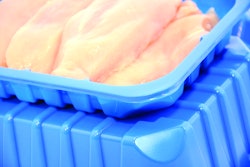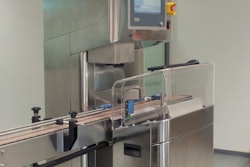Radio Frequency Identification (RFID) had existed for decades prior to being applied to consumer packaged goods (CPG); and, of those applications, the most ambitious is at the item-level. What's envisioned could not be more ambitious: every packaged good, worldwide, individually identifiable by means of an RFID-enabled tag. For practical reasons, the tag would be on the package in the overwhelming majority of instances; therefore, given the ubiquity of packaging in modern life, little imagination is required to grasp the potential scope and breadth of item-level RFID.
The stakeholders are diverse and their competing positions (more so than technological hurdles) have been the main impediments to the fulfillment of early predictions about RFID, which, in the main, have proven to have been overhyped. That's the past; and although the once predicted stampede has slowed to a crawl, is a complete stop (or even a reversal) inevitable?
The technology explained
RFID is a type of information technology (IT) whose components include a tag, a reader, and a computer system. A tag contains an antenna and an information-encoded microchip. The tag transmits its information, via radio waves, to a reader. The reader relays the information to a computer system. The computer system (typically connected to a database) makes decisions in accordance with its programming.
There are two types of tags. A passive tag does not have its own power source and is activated when radio waves are received from the reader. An active tag has its own power source (battery). Despite that difference, both types relate to the reader as described in the preceding paragraph; however, an active tag can be read from a greater distance than can a passive tag.
The Electronic Product Code (EPC)
The EPC should not be mistaken for a bar code. A bar code contains information at the SKU level, whereas an EPC contains information at the individual unit level. By way of example, the bar code identifies the item categorically (a box of a certain brand of cereal), but the EPC identifies the item specifically (an exact box of that brand of cereal, different from all others). Not every RFID application requires the exactness of an EPC, but EPC is at the core of RFID applications at the unit-level.
The Walmart influence
For consumer packaged goods, RFID is being used mostly at the pallet-level, tracking loads throughout the supply-chain. What modest use the technology enjoys in that application is due, in large part, to support from Walmart. In 2003, Walmart announced that it was mandating tagged pallet loads from its top 100 suppliers, the likely strategy being to quicken Walmart's ROI in the technology. Seemingly not pleased with the rate of compliance, in 2008 the mega-retailer started charging suppliers to its Sam's Club distribution center in DeSoto, TX, a $2 fee for every pallet load that was not RFID-enabled (for related reading, see Analyzing Sam's Club RFID fee, Packaging Insights, March 9, 2008).
Once Walmart's support for RFID became public, it was a foregone conclusion that it would fuel high expectations for that technology; after all, when it comes to drivers, Walmart is considered NASCAR. When expectations weren't met despite Walmar's support, RFID drew criticisms, some as harsh as calling it a bust. That criticism is undeserved because it overlooks the influence of other factors, discussed below.
Other factors
The CPG industry's resistance to item-level RFID reflects a perception that costs are unmatched by benefits. Even back when the focus was at the pallet level (let alone, the item level), the industry insisted that the price of tags was too high. For suppliers, it made for a type of Catch-22 situation, in that lower prices were predicated on higher quantities, but the prices at the time stymied higher quantities. Present prices are lower than those of, say, a decade ago, although likely not enough to entice many categories of CPG companies, notably those that operate on thinner profit margins. An even simpler explanation, less tied to the size of profit margins, is that tags constitute an avoidable cost, given the "non-cost" of bar codes incorporated into the packaging's graphics.
Then there's the factor of civil liberties, gnarly in terms of the imaginative lengths they can take. There are watchdog groups, for example, who decry item-level RFID as a serious threat to the consumer's privacy. They foresee circumstances in which not only is the store's tagged merchandise read, but also any tagged merchandise that consumers bring into the store. Those groups describe it as snooping into the purses and pockets of consumers. The groups warn that invasion of privacy can extend to homes and other private quarters, victimized by newer generations of readers with increased ranges. But are fleets of vehicles equipped with high-power readers penetrating buildings, and even curbside garbage, a credible concern? Or is this mere paranoia? The answer doesn't matter as much as the fact that the question exists; furthermore, who's to say that publicized concerns about alleged government surveillance of private citizens aren't bolstering the credibility of the RFID-related claims.
And it's unlikely that RFID ever will achieve maximum penetration in CPG industries without there being regulatory involvement, especially concerning privacy issues. Currently, there are no federal mandates that RFID-tagged consumer packaged goods carry disclosures to that effect. Nor are there mandates governing the use of scanners, for that matter. Modifications could be required of the Fair Packaging and Labeling Act; the Federal, Food, Drug and Cosmetics Act; and others among the various federal regulations that govern packaging. And given the meticulous, step-wise-and, yes, often slow-process that regulatory changes undergo, an overnight impetus from that source shouldn't be expected.
The future to the rescue?
Despite the less-than-stellar growth of RFID at the item-level and the various challenges still operating, CPG companies should not consider it a dead topic; rather, they should have in place a plan for staying current on developments. Consider Walmart's use of item-level tagging of apparel. Another consideration is that the U.S. Department of Defense is a major backer of RFID, and there have been occasions of advances coming out of government programs and afterward being adopted for civilian purposes.
And not to be overlooked are the many predictions concerning a "smart" future, where retail shelves communicate with aisle screens and shopping carts, and household appliances monitor the freshness of their contents and even place retail reorders. Somewhere in that backdrop, there would seem to be a natural role for "smart" packaging. Why not RFID? Ultimately, RFID might prove to be the equivalent of the famous wit, Mark Twain, who is said to have once affirmed that reports of his demise had been greatly exaggerated.



























